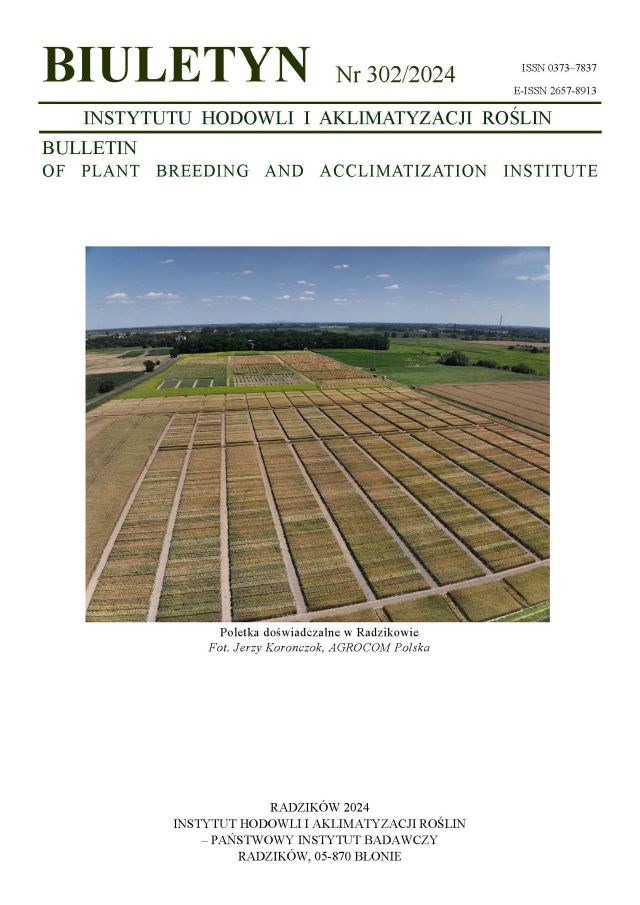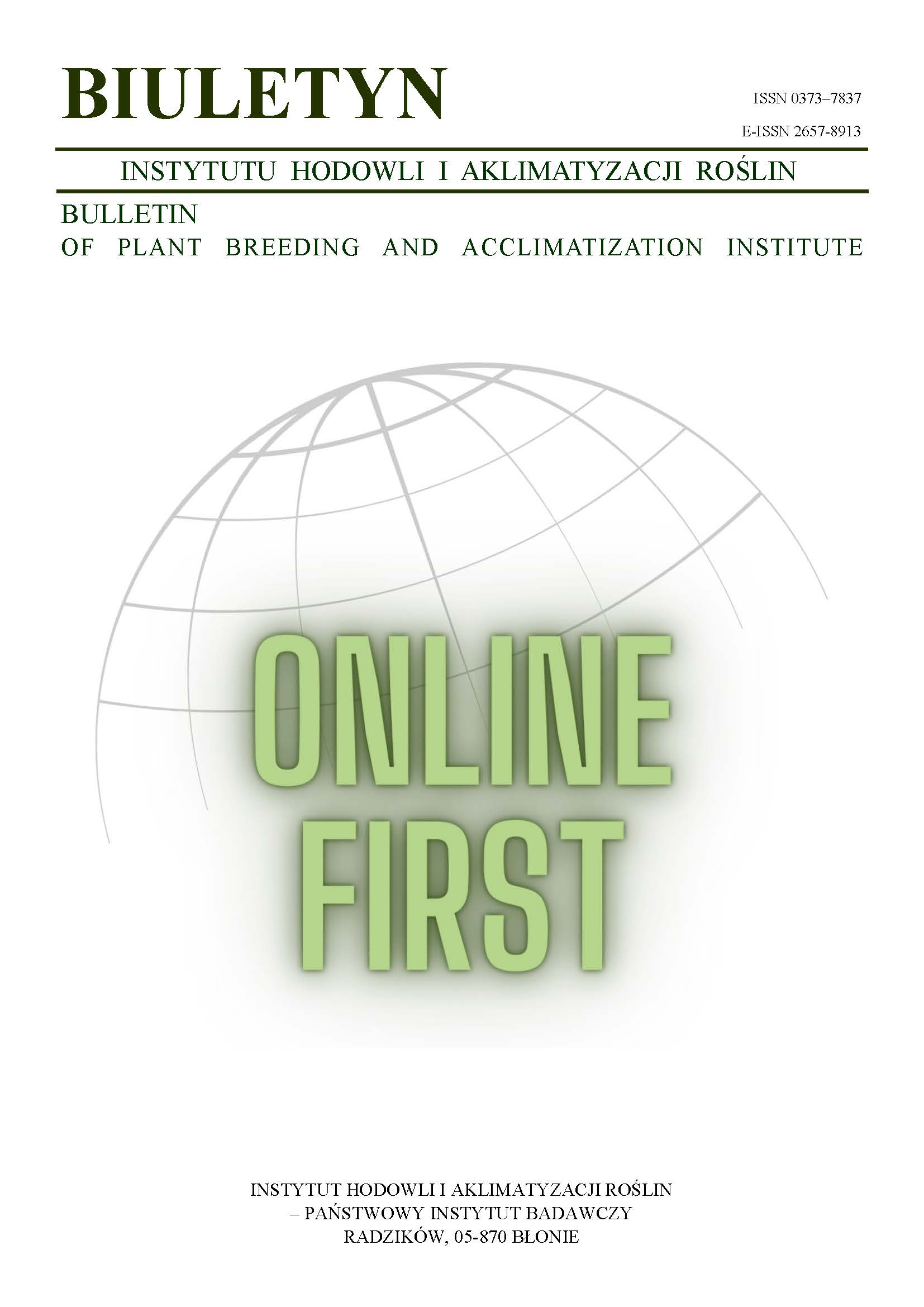The efficiency of wheat haploid production from F1 hybrids and parental genotypes by crossing with maize
Karolina Krystkowiak
office@igr.poznan.plInstytut Genetyki Roślin PAN, Poznań (Poland)
Anetta Kuczyńska
Instytut Genetyki Roślin PAN, Poznań (Poland)
Michał Rębarz
Instytut Genetyki Roślin PAN, Poznań (Poland)
Renata Trzeciak
Instytut Genetyki Roślin PAN, Poznań (Poland)
Abstract
The aim of this study was to compare wheat F1 hybrids and their parents in terms of main parameters connected with the efficiency of haploid production by wheat × maize crosses. The material for the study covered F1 hybrids and parental genotypes of the following cross combinations: Alidos × Kobra, Alidos × Kris, Alidos × Mikon, Alidos × Elena, Batis × Charger, Batis × Kris, Kornett × Elena, Kornett × Kobra. The experiment was carried out in a complete randomised design with four replications. The number of ovaries, ovaries with embryos and developed haploid plants were observed. The hybrids Alidos × Kobra and Alidos × Kris gave a higher percent of ovaries with embryos than their parents. In Kornett × Kobra and Alidos × Kris a number of haploids per 100 cultured embryos was higher than that in parental genotypes. Our results confirmed influence of genotypes on efficiency of wheat haploidization, and showed the higher effectively of haploid production from F1 hybrids than from parental cultivars.
Keywords:
haploids, in vitro culture wheat, wheat × maize crossesReferences
Adamski T., Ponitka A., Surma M., Ślusarkiewicz-Jarzina A. 2001. Otrzymywanie linii podwojonych haploidów u zbóż, instrukcja wdrożeniowa. IGR PAN, Poznań.
Google Scholar
Barclay I. R. 1975. High frequencies of haploid production in wheat (Triticum aestivum L.) by chromosome elimination. Nature 256: 410 — 411.
DOI: https://doi.org/10.1038/256410a0
Google Scholar
Gamborg O. L., Miller R. A., Ojima K. 1968. Nutrient requirements of suspension cultures of soybean root cells. Exp. Cell Res. 50: 157 — 158.
DOI: https://doi.org/10.1016/0014-4827(68)90403-5
Google Scholar
Laurie D. A., Bennett M. D. 1986. Wheat × maize hybridization. Can. J. Genet. Cytol. 28: 313 — 316.
DOI: https://doi.org/10.1139/g86-046
Google Scholar
Laurie D. A., Bennett M. D. 1988. The production of haploid wheat plants from wheat × maize crosses. Theor. Appl. Genet. 76: 393 — 397.
DOI: https://doi.org/10.1007/BF00265339
Google Scholar
Laurie D. A., Bennett M. D. 1989. The timing of chromosome elimination in hexaploid wheat × maize crosses. Genome 32: 953 — 961.
DOI: https://doi.org/10.1139/g89-537
Google Scholar
Laurie D. A., O’Donoughue L. S., Bennet M. D. 1990. Wheat × maize and other wide sexual hybrids: Their potential for genetic manipulation and crop improvement. In: Gene Manipulation in Plant Improvement. II Proc. 19th Stadler Genet. Symp. J. P. Gustafson (ed.), Plenum Press, New York: 95 — 126.
DOI: https://doi.org/10.1007/978-1-4684-7047-5_6
Google Scholar
Lefebvre D., Devaux P. 1996. Doubled haploids of wheat × maize crosses: genotypic influence, fertility and inheritance of the 1BL-1RS chromosome. Theor. Appl. Genet. 93: 1267 — 1273.
DOI: https://doi.org/10.1007/BF00223459
Google Scholar
Lei Z. S., Zhou Y., Hai Y., He X. C., Lin Z. J., Zhang S.C., Yang H. M., Huang B. Y., Lai Q. R. 1996. Efficient wheat haploid production by wheat × maize. Proc. of 5th International Wheat Conference, Ankara, Turkey, 374.
Google Scholar
Suenaga K. 1994. Doubled haploid system using the intergeneric crosses between wheat (Triticum aestivum L.) and maize (Zea mays L.). Bulletin of the National Institute of Agrobiological Resources (Japan) 9: 83 — 139.
Google Scholar
Wędzony M., Marcińska I., Ponitka A., Ślusarkiewicz-Jarzina A., Woźna J. 1998. Production of doubled haploids in triticale (X Triticosecale Wittm.) by means of crosses with maize (Zea mays L.) using Picloram and Dicamba. Plant Breed. 117: 211 — 215.
DOI: https://doi.org/10.1111/j.1439-0523.1998.tb01928.x
Google Scholar
Wędzony M., Van Lammeren A. A. M. 1996. Pollen tube growth and early embryogenesis in wheat × maize crosses influenced by 2,4-D. Annals of Botany 77: 639 — 649.
DOI: https://doi.org/10.1093/aob/77.6.639
Google Scholar
Authors
Anetta KuczyńskaInstytut Genetyki Roślin PAN, Poznań Poland
Authors
Michał RębarzInstytut Genetyki Roślin PAN, Poznań Poland
Authors
Renata TrzeciakInstytut Genetyki Roślin PAN, Poznań Poland
Statistics
Abstract views: 80PDF downloads: 17
License
Copyright (c) 2004 Karolina Krystkowiak, Anetta Kuczyńska, Michał Rębarz, Renata Trzeciak

This work is licensed under a Creative Commons Attribution-ShareAlike 4.0 International License.
Upon submitting the article, the Authors grant the Publisher a non-exclusive and free license to use the article for an indefinite period of time throughout the world in the following fields of use:
- Production and reproduction of copies of the article using a specific technique, including printing and digital technology.
- Placing on the market, lending or renting the original or copies of the article.
- Public performance, exhibition, display, reproduction, broadcasting and re-broadcasting, as well as making the article publicly available in such a way that everyone can access it at a place and time of their choice.
- Including the article in a collective work.
- Uploading an article in electronic form to electronic platforms or otherwise introducing an article in electronic form to the Internet or other network.
- Dissemination of the article in electronic form on the Internet or other network, in collective work as well as independently.
- Making the article available in an electronic version in such a way that everyone can access it at a place and time of their choice, in particular via the Internet.
Authors by sending a request for publication:
- They consent to the publication of the article in the journal,
- They agree to give the publication a DOI (Digital Object Identifier),
- They undertake to comply with the publishing house's code of ethics in accordance with the guidelines of the Committee on Publication Ethics (COPE), (http://ihar.edu.pl/biblioteka_i_wydawnictwa.php),
- They consent to the articles being made available in electronic form under the CC BY-SA 4.0 license, in open access,
- They agree to send article metadata to commercial and non-commercial journal indexing databases.
Most read articles by the same author(s)
- Maria Surma, Tadeusz Adamski, Karolina Krystkowiak, Anetta Kuczyńska, Krzysztof Mikołajczak, Piotr Ogrodowicz, Functional markers for quantitative traits , Bulletin of Plant Breeding and Acclimatization Institute: No. 264 (2012): Regular issue
- Tadeusz Adamski, Andrzej Bichoński, Zdzisław Biliński, Zbigniew Bystry, Piotr Jarosz, Dorota Jasińska, Zygmunt Kaczmarek, Karolina Krystkowiak, Anetta Kuczyńska, Wojciech Mikulski, Barbara Nowak, Wanda Orłowska-Job, Zdzisław Paszkiewicz, Michał Rębarz, Maria Surma, Anna Sybilska, Renata Trzeciak, The genotype-environment interaction for barley lines from different breeding stations , Bulletin of Plant Breeding and Acclimatization Institute: No. 249 (2008): Regular issue
- Maria Surma, Tadeusz Adamski, Anetta Kuczyńska, Karolina Krystkowiak, Renata Trzeciak, Krzysztof Mikołajczak, Piotr Ogrodowicz, Modified single seed descent technique in winter barley breeding , Bulletin of Plant Breeding and Acclimatization Institute: No. 262 (2011): Regular issue
- Tadeusz Adamski, Zygmunt Kaczmarek, Maria Surma, Anetta Kuczyńska, Karolina Krystkowiak, Bolesław Salmanowicz, Renata Trzeciak, Zofia Banaszak, Bogusława Ługowska, Małgorzata Majcher, Wiktor Obuchowski, Multivariate analysis of some quality traits of winter wheat grain , Bulletin of Plant Breeding and Acclimatization Institute: No. 260/261 (2011): Regular issue
- Tadeusz Adamski, Maria Surma, Aleksandra Ponitka, Aurelia Ślusarkiewicz-Jarzina, Karolina Krystkowiak, Anetta Kuczyńska, Hanna Pudelska, Krzysztof Rubrycki, Renata Trzeciak, Jolanta Woźna, Production efficiency of wheat haploids by anther culture and wheat × maize crosses , Bulletin of Plant Breeding and Acclimatization Institute: No. 252 (2009): Regular issue
- Tadeusz Adamski, Maria Surma, Zygmunt Kaczmarek, Anetta Kuczyńska, Krzysztof Mikołajczak, Michał Kempa, Piotr Ogrodowicz, Elżbieta Adamska, Renata Trzeciak, Alina Anioła, Renata Holewińska , Studies on the effect of 1B/1R translocations on the efficiency of obtaining wheat DH lines and their technological value , Bulletin of Plant Breeding and Acclimatization Institute: No. 286 (2019): Special issue
- Anetta Kuczyńska, Maria Surma, Tadeusz Adamski, Paweł Krajewski, Krzysztof Mikołajczak, Piotr Ogrodowicz, Michał Kempa, Hanna Ćwiek-Kupczyńska, Renata Trzeciak, Effects of drought on the development and architecture of barley root system , Bulletin of Plant Breeding and Acclimatization Institute: No. 286 (2019): Special issue
- Karolina Krystkowiak, Tadeusz Adamski, Maria Surma, Zygmunt Kaczmarek, Anetta Kuczyńska, Variation of wheat cultivars with regard to agronomic traits estimated by uni- and multivariate analysis , Bulletin of Plant Breeding and Acclimatization Institute: No. 253 (2009): Regular issue
- Karolina Krystkowiak, Tadeusz Adamski, Maria Surma, Zygmunt Kaczmarek, Anetta Kuczyńska, Agata Burtna, Renata Trzeciak, Variability of chosen technological traits of winter wheat hybrids in relation to composition of HMW glutenin subunits in parental forms , Bulletin of Plant Breeding and Acclimatization Institute: No. 260/261 (2011): Regular issue
- Wojciech Rybiński, Karolina Krystkowiak, Anetta Kuczyńska, Michał Rębarz, Variability of hull-less barley mutants (Hordeum vulgare L.) at the phenotypic and molecular levels , Bulletin of Plant Breeding and Acclimatization Institute: No. 245 (2007): Regular issue














